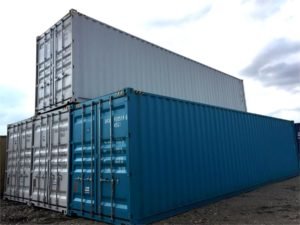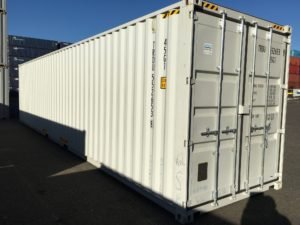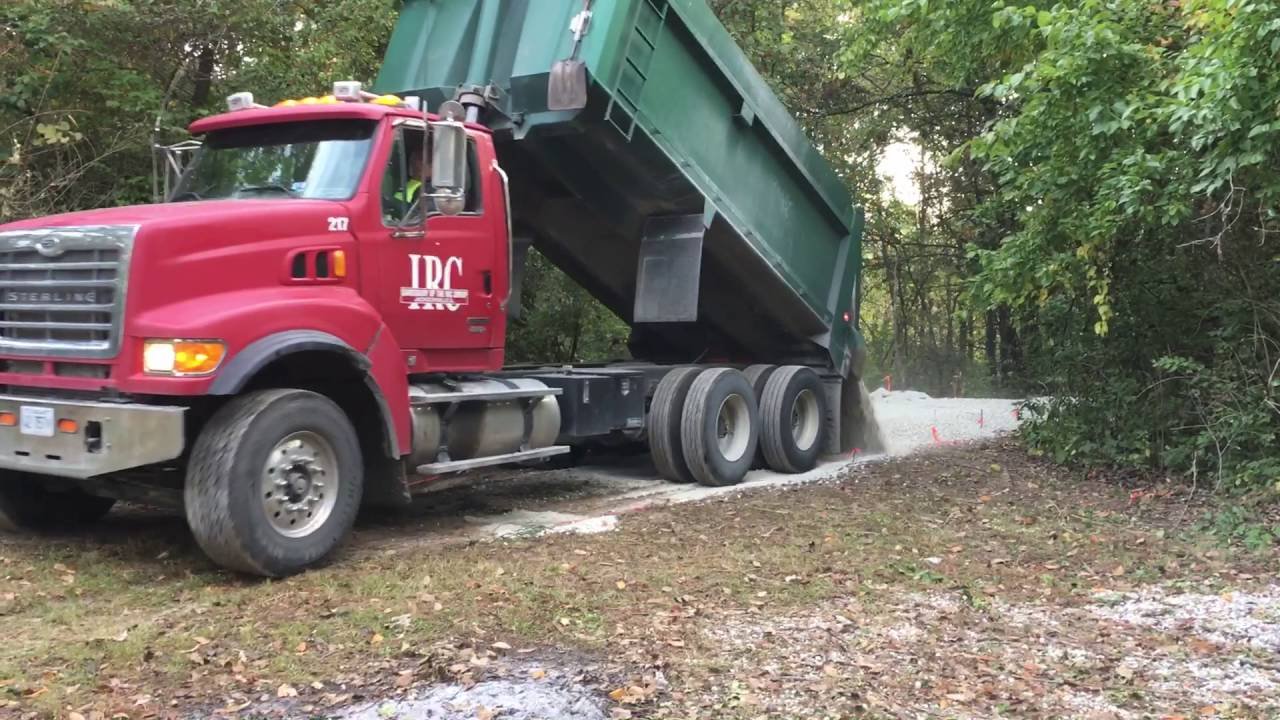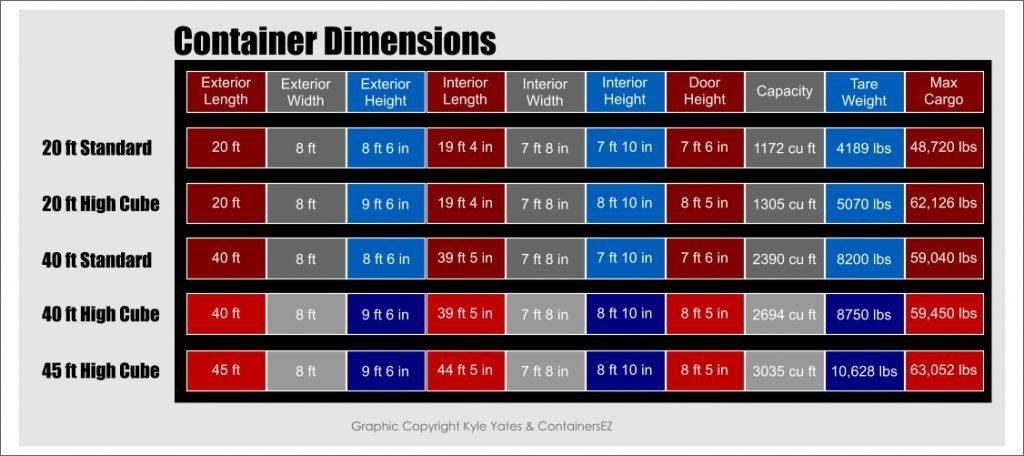What is a “GP” Container?
General purpose shipping containers are the most well-known and recognized containers in use today. Used to transport goods and cargo by sea and land, they’re strong, watertight, and incredibly durable.
Made with solid Corten steel with reinforced corners to enable stacking up to 8 containers high on the exposed decks of a ship on long voyages around the world, they’re built to survive the worst nature can throw at them.

What is the difference between a Standard (height) Container and a “High Cube” Container?
The shipping container industry uses containers in two different heights.
The “Standard” height, which is 8’6” externally and 7’10” internally.
The second unit is called a “High Cube” height container and is exactly 1 foot taller measuring 9’6” externally and 8’10” internally.
Obviously, each unit has different weight and capacity specifications. See our container dimensions chart for more on this.
High Cube container can be told by the yellow and black stripped tape at the top front corners of the container esp. above the container doors. A Large sign can usually be found on one the doors of a High Cube container stating that the container in 9’6” in height…this sign is circled in the photo below.
A Standard unit on the left compared to a High Cube Unit on the Right. Notice the large 9’6” sign on the High Cube and the Yellow and Black striped tape above the doors of the High Cube unit.

Yellow and Black stripped “flagging” Tape can usually be found at the front corners of a High Cube Container.

When should I use high cube containers?
Excellent examples of times and conditions to use a High Cube container are:
-Transport and/or storage of cargo that requires more head space but needs to be in closed environment
-For temporary work and workshop space, it adds additional container height for lighting and makes the space more roomy and comfortable
-Perfect storage solution for both industrial and commercial sectors which requires bigger storage space
You can see the differences in Shipping Container Dimensions in our chart below.
How do I find out the codes or regulations that may affect having a container on my property?
Determine the exact address of where you want the container delivered. Once you have decided upon the address where you container will be located, then take that address and look up to determine if it is in an incorporated city or on county land.
If it falls within the limits of an incorporated city then call that particular city hall. If it falls in an unincorporated area (on county land-outside of an incorporated area) then call that specific county.
When you call the appropriate municipality, again, as determined by the container’s delivery address, then ask to speak to “property code compliance.” Speak to the person in property code compliance and tell them the delivery address where you want to locate a container. Determine, from the property code compliance person, the exact regulations that may apply to locating the container on the property in question.
Tips:
1) Always ask the code compliance person to send you an official email outlining any/all applicable code(s) or regulation(s) that apply to locating you container.
2) A city or county may change or modify their policy at a later date and you should always have this communication as proof of the regulations as of the date you located your container. Be sure to print this letter and file away.
3) Keep a copy of any communications you have or filings that you make regarding your container.
4) Shipping containers may actually qualify as “buildings” by some ordinances. Thus, they may be treated accordingly. Be aware of this.
How much space do I need to place my container?
Important: Your terrain should be firm, leveled, smooth, truck accessible, and free of obstructions.
40ft Containers require a minimum clearance of: 120ft length, 16ft height, and 10ft width.
20ft Containers require minimum clearance of: 70ft length, 16ft height, and 10ft width
If your delivery site has special conditions like:
-a greater than 4% grade driveway
-horseshoe bends
-‘S’ curve
-does not meet the requirements listed above
-or if you simply have some questions, call ContainersEZ at (805) 206-6963 and we will gladly assist you with your delivery.
Note: Our “pinpoint” winch tilt delivery is to give our customers the excellent delivery that they should have. We will not use any other delivery method unless requested by the customer.
I want my container doors to be at the bottom of my driveway. Can you make sure this happens?
What you are asking for is called “doors of last.” Doors of last means that the doors of the container are at the cab end of the truck when delivery occurs. When the container is tilt delivered off the truck, the doors come off lastly. Thus, the phrase “doors off last.”

Conversely, “doors off first” means that the doors of the container are at the tail end of the delivery truck when your container is delivered. When the container is tilted and placed the doors wind up at the far end away from the delivery truck.
Using the driveway scenario: Doors off first puts the doors at the top of the driveway.
What is meant by “preparing” my (container) ground? Why is that needed?
Preparing your ground is important. The ground will ultimately absorb water from rainfall, irrigation or many other means.
A container that is simply sitting on plain solid earth will “suffocate” the ground and not allow the moisture to evaporate freely. The moisture will escape in one direction - straight up into the plywood flooring of the container.
No matter how well constructed, the plywood in your container will rot out within a few years if the container is placed directly on the ground in this condition.
To receive the flooring portion of our container warranty, we require all customers to raise the container at least 3 inches off the ground to protect the flooring structure.
The container delivery area needs to be level and hard packed ground. There are two ways to “prepare” your ground to protect the flooring of your container.
Method I: Gravel pad.
Get 3-3.5 inches of packed gravel on the exact ground where your container will be resting. The size of the gravel pad should be the exact length and width of your container.
Only packed gravel will keep moisture from rotting your plywood flooring. Even though you may choose this method it is required that your container still be elevated a minimum of 3 inches at the columns (upon delivery) to receive the flooring portion of your warranty.
A gravel company can bring in the gravel for you, level it, and compact it for you as well.

Method II: On boards/blocks.
Have pressure treated 4X4 or 6X6 boards ready to be place at both extreme ends of your container’s delivery area.
We recommend 6X6 instead of 4X4 because they are typically better because of their larger size. The higher quality wood the better. Each strip should be the width of the container…8 feet. Typically, 8 foot widths are the standard and easy to obtain.
In areas where the ground is not hard then we advise using cornerstone bricks at each corner of the container with 6X6 going across the bottom and resting on the cornerstones. The bricks can give the boards better stability and less chance of the container sinking over time.
Tips
Either of the above solutions requires level and firm ground for the delivery area.
We strongly advise against using cinder blocks because they can crack and cause problems down the road. The delivery driver will assist you in getting the container placed properly.
How can I get my container faster?
Our typical delivery occurs within 72 hours after your payment being cleared. In certain cases we can hurry things faster, but the trucking schedule and your method of payment clearing are the top factors in this.
How can I tell when my container was manufactured?
Most containers come with a large silver tag on the left-hand door. This tag is called a CSC Plate. The CSC Plate gives all the pertinent information regarding the manufacture date and origin of the container.
After I purchase my container, how will I know it will still be sealed tight years later? This is a big purchase, I need it to last!
Everything wears down. That being said, at ContainersEZ we take that into account by only selling a high-quality container. Our containers are backed by our Watertight/Corrosion-Resistant Warranty. Your container should have no issues with its watertight seal or any issues with leaking or corrosion. We guarantee it. If there are any issues, you let us know. We will send someone out to fix it at our expense. This warranty covers your container purchase for up to eight (8) years.
Warranty Summary:
5-Star/Brand New/1-Trip units are warrantied for eight (8) years.
Pre-Owned units come with the same warranty but as follows:
4-Star Excellent Used Containers are covered for five (5) years.
3-Star units are backed by a 3-Year warranty
2-Star units come with a 2- Year warranty.
We back pre-owned units because we are selective in what we sell. We will not sell a container unless we can truly say “it is of such quality, that it will easily exceed the duration of its warranty without issue.”
We will even give our customers tips and instructions on how to make their container last even longer. Nobody else goes to that extent…nobody.
Satisfied customers and quality containers are the hallmarks of ContainerEZ.
To learn more about our Protection Policy, click here.
I need a container moved off of my property. I now own this property, but I do not need the container that came with it. How do I get it out of here?
Answer: simply give us a call and we can gladly assist you here. We help people in this way-all the time. Give us a call at (805) 206-6963.
We are open 7:00AM-7:00PM (Pacific Time) 7 days a week.
